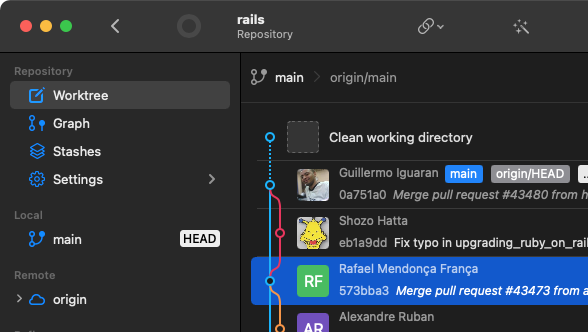

Next using I was able to reproduce not only the single commands, but also target other devices from the Raspberry Pi. Use `echo “scan” | cec-client RPI -s -d 1` to determine the source address (2.0.0.0) and source (Recording2) of the Raspberry Pi.

Running the single commands above with debug on (-d 1) allowed me to see what address/source it was using for the Raspberry Pi, then the rest sort of fell into place. Partly it was confusion on my part about what the addresses of the devices were. Honestly it took me longer then it should have to understand how the HDMI-CEC frames worked.
#GIT GUI CLIENT FOR RASPBERRY PI TV#
It is possible to turn the TV on or off (standby) from the Raspberry Pi.Įcho "standby 0" | cec-client RPI -s -d 1 In other words, from the Raspberry Pi I can only send commands to the Raspberry Pi (make active / inactive source) and not send from the Raspberry Pi commands to make the Tivo or PlayStation active. However, using this approach I was not able to send commands from one device to another devices. The following is the simplest way to call the cec-client, with no address specified. But I am getting ahead of myself… Single Commands With the ability to send a HDMI-cec frame I believe I can remove it from the setup, as I can address the device from the Raspberry Pi. NOTE: The Tivo is old enough not to support cec, so originally I bought the Pulse Eight USB-CEC adapter when I was only using the single command approach. This will include the TV, the Raspberry Pi and any other devices, typically listed as either `Recorder #` or `Playback #`. The First step is to use the cec-client on the Raspberry Pi to scan the HDMI devices. NOTE: This will work with Raspbian as well, as OMSC (Open Source Media Center) just a repackaging of Raspbian.
#GIT GUI CLIENT FOR RASPBERRY PI HOW TO#
These are notes on how to use `cec-client` and understand the different options. Using a Raspberry Pi connected to a TV that supports CEC, you can use the command line `cec-client` application to control the inputs and the TV itself. Samsung Anynet+, LG SimpLink, Sharp Aquos Link) but it may need to be enabled. It is very convenient and useful, sort of a universal remote that works.Įvery manufacturer seems to have it’s own branding of CEC (e.g. If you have ever turned on a Game Console and had your TV automatically change input to that device you have seen CEC in action. It allows devices to send commands to each other, typically to get the TV to switch input and control volume. Most modern HDMI connected devices support Consumer Electronics Control (CEC).


 0 kommentar(er)
0 kommentar(er)
